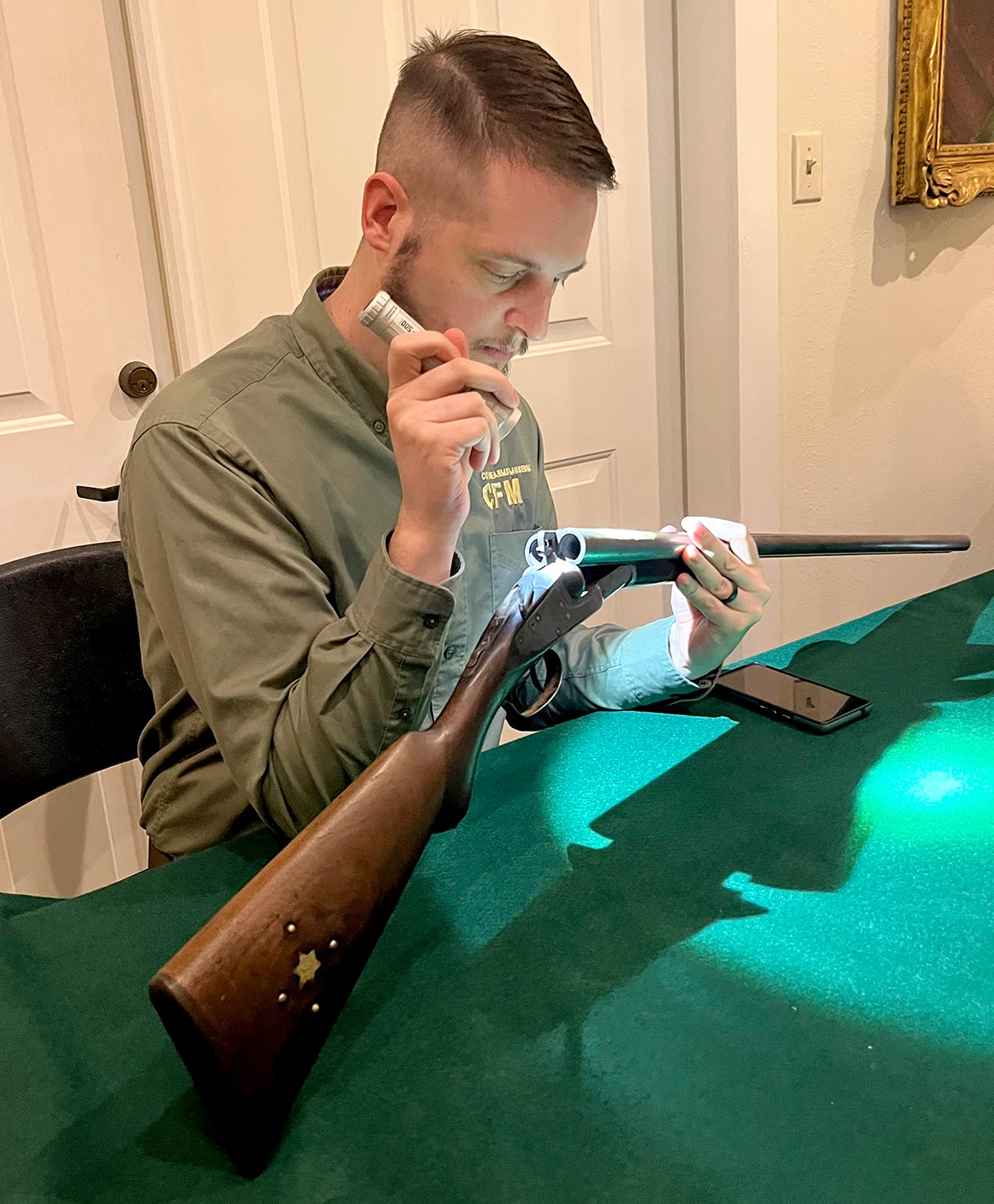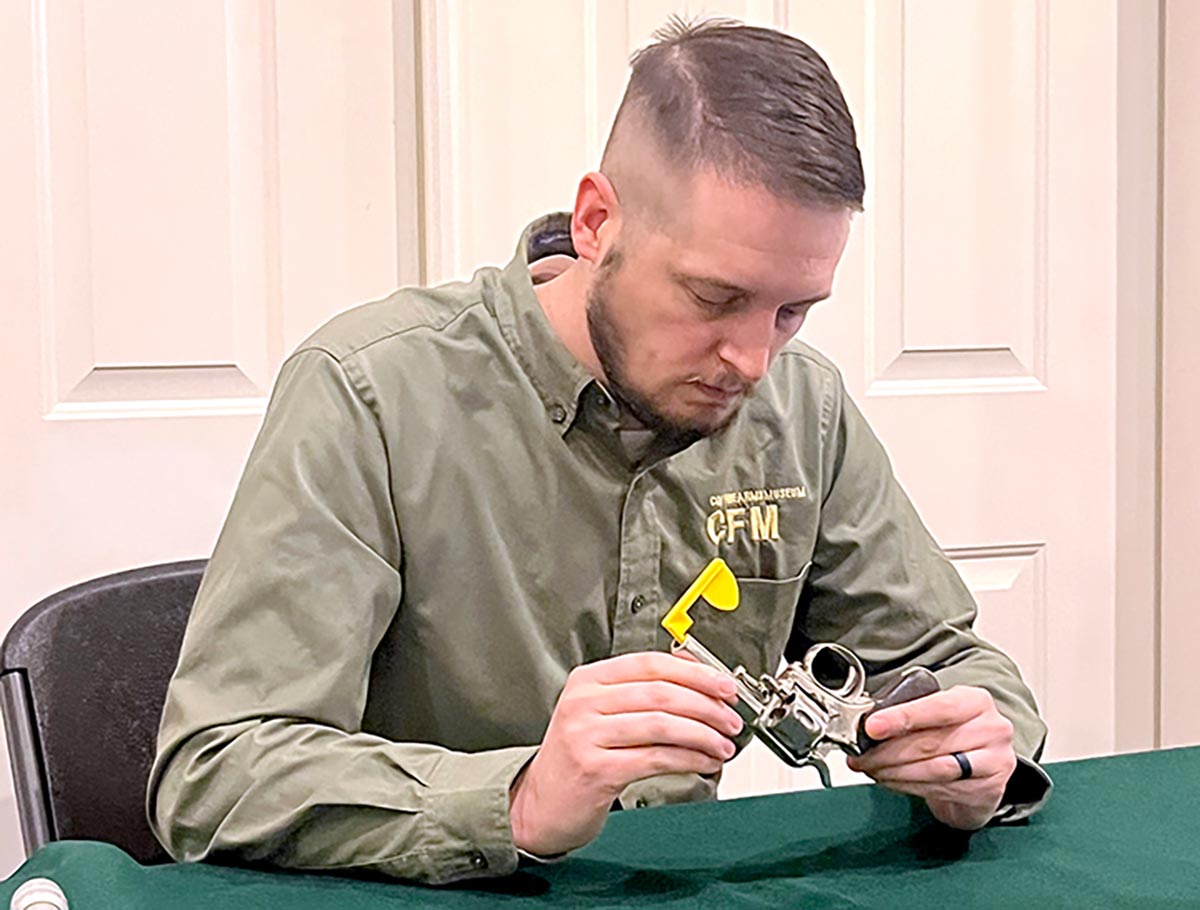
MWH lecture explores rich history of American firearms
The American West was built on a foundation of cowboys, horses and guns. Of the three, guns are still prominent in society.
Danny Michael, curator of the Cody Firearms Museum in Wyoming, presented a lecture, “History with A Bang: Firearms of the American West,” at the McFaddin-Ward House, Feb. 20.
The lecture focused on the period from Lewis and Clark’s 1807 expedition to chart the western frontier journey through to the 1920s.
Michael said Hollywood scenes of stagecoaches, train robberies and high noon shootouts have shaped people ideas of Wild West weaponry.
“In every movie the cowboy’s wearing a six shooter,” he said. “Most of the movies he’s got a lever action rifle. If you look closely at the details in those movies, it’s usually one of these two.”
Michael said many Wild West stories come from people who lived them. They are then embellished by novelists. And once they get picked up by movies, they get more embellished.
“A movie like ‘Winchester 73,’ where the rifle is actually the star of the show, informs a lot of what we think,” he said. “Pop culture informs a lot of what we think about the past in any given topic. There’s some truth to it.”
Historians can learn about which weapons were used and why they were used through multiple factors, Michael said, Looking at the firearm itself, photos of people handling the firearm, military records and written accounts all tell the story of the firearm.
Lewis and Clark carried an unorthodox gun called the Girardoni air rifle, named after its inventor, that was rarely seen in the American West, Michael said. The weapon holds 20 to 22 projectiles, and to shoot it one pumps the butt stock with an air pump.
“People don’t think of air rifles as powerful this early, but it was originally made for the Austrian military,” he said. “They issued it to sharpshooters. Lewis and Clark saw one in Philadelphia and got their hands on it. It was an unusual gun to take with them. There are not many surviving ones.”
In the mid-1800s, the gun scene was dominated by the classic American western rifles. These included the plains rifle, the mountain man rifle and the Hawken rifle, Michael said. The Hawken rifle got the name from two brothers.
“They were gunsmiths,” he said. “They learned the gunsmithing trade from their father, Christian Hawken, in western Maryland. Their whole family made guns. Without a doubt, they are the most famous family to make guns.”
Michael said the Hawken rifle was the gun to have in the 1840s. If someone was headed west and they could afford it, they had it.
Jeremiah Johnson, who was played by Robert Redford in the movie of the same name, was a mountain man and an interesting character in the West, Michael said.
“He served in the Mexican American War and married a woman,” he said. “She gets murdered, and he vows revenge. He goes after the tribe that murdered her, and allegedly, when he killed one of the warriors from that tribe, he would eat their liver.”
Michael said firearms came to the country from both coasts and were traded freely.
“There were a lot of active Russian traders in that area,” he said. “The guns would travel faster than the settlement sometimes. As European settlers arrive on the East Coast and Russian traders come down the Pacific Coast, guns become a trade good. The guns would be used as bargaining chips with (Native American) tribes.”
Michael showcased different types of guns that were traded such as muskets and flintlocks.
Western expansion was paused at the start of the Civil War. When the war ended, there was a surplus of guns, including Joslyn revolvers and muskets, and the government decided to sell them.
“If you were a Union soldier, you had a chance to buy your gun on the way out of the service,” Michael said. “They sold off a surplus to companies and a lot of these guns are available. In fact, they’re available extremely cheap. There are records of some of these guns selling for as little as $2 at the time.”
Michael said it helped people get a cheap gun rather than spending $35 on a brand-new Winchester.
“If you’re trying to save up your money and have enough money to survive out in the West and buy other goods, that is a really strong value proposition that you have to weigh in the balance,” he said.
Michael talked about William F. Cody, also known as Buffalo Bill. The town where Michael works is named for him.
“He became so famous because he lived the experience of the American West and then he told stories based on that experience,” he said. “He wasn’t just a dime novelist who was making up a story and he wasn’t one of those mountain men that couldn’t communicate. He had a personality and could communicate, and he lived the experience.”
Guns like the Winchester 1873 and the Colt 1873 were both weapons used in Hollywood and the West.
Probably the most recognizable name is the Colt revolver, often referred to as six shooters. There are safety risks that come with them, Michael said. When the Colt is fully loaded, it runs the risk of firing on its own. There were times that a person would be riding their horse, and all the bouncing around caused the gun to go off and shoot into the person’s leg. In fact, Michael said, this happens now with people on ATVs.
Michael’s lecture highlighted the importance of guns to western settlers. It wasn’t just a weapon — it was a way of life and a way to survive.

